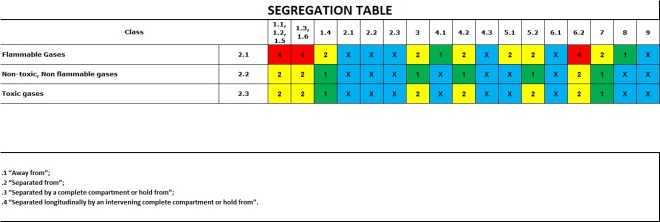Among the model regulations for transport of Dangerous Goods, Rail, Road, River, Air and Sea, the most stringent regulations for segregation of Dangerous Goods is stipulated by IMDG Code. IMDG Code is applicable to all ships to which the International Convention for the Safety of Life at Sea, 1974 (SOLAS 74), as amended, applies and which are carrying dangerous goods as defined in regulation 1 of part A of chapter VII of that Convention.
General Segregation as per IMDG Code
Part 7, Chapter 7.2, describes every step necessary to keep “away from”, “separated from” or in different cargo holds or the requirement of intervening cargo holds for segregating dangerous goods. The provisions of segregation varies as the extend of hazard arising may vary. Any two goods must be segregated if mixing of both may result in undue hazard.
IMDG Code segregation rules, which includes, segregation table, special provisions of segregations and segregation groups deals with segregating dangerous goods from other dangerous goods.
The basic rationale applied is as below.
- Chemicals belonging to same reactive groups to be segregated from other groups which can cause dangerous reactions and result in
- combustion and/or evolution of considerable heat;
- evolution of flammable, toxic or asphyxiant gases;
- the formation of corrosive substances; or
- the formation of unstable substances.
This is mainly addressed through segregation groups, section 7.2.5 of IMDG Code.
- Even though they many not react with each other but together when involved in fire extend of hazard will increase. This is generally addressed through segregation table. Section 7.2.4. of IMDG Code.
Consolidation of Dangerous and Non-Dangerous Goods
When it comes to consolidation of dangerous goods and non- dangerous goods, in same container, IMDG Code places the responsibility on the shoulders of consignor or the person responsible for packing the goods into a container through section 7.2.5.4 as quoted below:
It is recognized that some non-hazardous substances have similar chemical properties as substances listed in the segregation groups. A consignor or the person responsible for packing the goods into a cargo transport unit who does have knowledge of the chemical properties of such non-dangerous goods may decide to implement the segregation requirements of a related segregation group on a voluntary basis.
Some of the reactive groups
Acrylic Acids, Alcohols and Polyols Aldehydes, Alkynes, with Acetylenic Hydrogen, Alkynes, with No Acetylenic Hydrogen Amides and Imides, Amines, Aromatic, Amines, Phosphines, and Pyridines, Anhydrides, Aryl Halides, Azo, Diazo, Azido, Hydrazine, and Azide Compounds, Bases, Strong Bases, Weak Carbamates, Carbonate Salts, Chlorosilanes, Conjugated Dienes Cyanides, Inorganic Epoxides, Esters, Sulfate Esters, Phosphate Esters, Thiophosphate Esters, and Borate Esters, Ethers, Fluorinated Organic Compounds, Halogenated Organic Compounds,Halogenating Agents, Hydrocarbons, Aliphatic Saturated, Hydrocarbons, Aliphatic Unsaturated, Hydrocarbons, Isocyanates and Isothiocyanates, Ketones, Metal Hydrides, Metal Alkyls, Metal Aryls, and Silanes Metals, Alkali, Very Active Metals, Elemental and Powder, Active Metals, Less Reactive Nitrate and Nitrite Compounds, Inorganic Nitrides, Phosphides, Carbides, and Silicides Nitriles Nitro, Nitroso, Nitrate, and Nitrite Compounds, Organic Non-Redox-Active Inorganic Compounds Not Chemically Reactive, Organometallics, Oxidizing Agents Oximes Peroxides, Organic Phenolic Salts, Phenols and Cresols, Polymerizable Compounds, Quaternary Ammonium and Phosphonium Salts, Reducing Agents Salts, Acidic Salts, BasicSiloxanes, Sulfides, Inorganic Sulfides, Organic Sulfite and Thiosulfate Salts Sulfonates, Phosphonates, and Thiophosphonates, Organic Thiocarbamate Esters and Salts/Dithiocarbamate Esters and Salts, Water and Aqueous Solutions.
Carrier’s Responsibility
Those who work in Carrier’s Dangerous Goods Desk normally gets a lot of enquiries from shippers, consolidators and/or freight forwarders whether such and such dangerous goods can safely be loaded in same container with such and such non-dangerous goods. Mostly these questions are initiated by Carrier’s booking team.
What should the Carrier’s Dangerous Goods Specialist reply to above question?
Carrier’s DG expert can use their own judgement to permit loading dangerous goods and non-dangerous goods consolidation provided such a consolidation is at least as effective and safe as that required by IMDG Code. Shippers should realize that the Carrier’s DG expert is working on behalf of vessel’s Master to ensure compliance to Regulation 2(3) of SOLAS 1974, as amended, which says “The carriage of dangerous goods in packaged form is prohibited except in accordance with the provisions of Chapter VII, Part A”.
Any goods which can violently react with each other and effect the minimum safety as required by IMDG Code must not be loaded in same container. This is applicable to dangerous goods as defined by IMDG Code and non-dangerous goods.
Where the case of food is concerned IMDG Code makes sure, to protect lives, that non compatible goods are not loaded together with foodstuff. This is stipulated through section 7.3.4.2, Segregation in relation to foodstuffs, of IMDG Code. Foodstuff is defined as “foodstuffs, feeds or other edible substances intended for consumption by humans or animals”.
Case Study
While I was heading a global container line’s Dangerous Goods Department I had encountered an interesting FAK consol box. Consolidator wanted to load many different goods into a 40 FT GP box out of which there was Class 6.1, Toxic, liquids and toothpaste with less than ½ a meter separation between. I refused to accept same on my vessel. Consolidator argued as per definition of IMDG Code, Chapter 1.2, toothpaste is not food stuff as it is not made for human or animal consumption. His argument was correct in the letter and spirit. Still I refused to accept the box on the booked vessel and any vessel in my fleet stating that knowingly I will not accept toothpaste to be kept with poison and endanger the health of people.
Due Diligence needed
Carrier must always take due diligence to protect themselves so are shippers, forwarders and consolidators. The utmost is to uphold the relevant provisions of SOLAS and MARPOL. No economy or business interest can outdo Safety, Health and Environmental Protection.
Way forward
Use your knowledge, consult experts, do whatever you can, to ensure consolidation of goods will not jeopardize safety!









